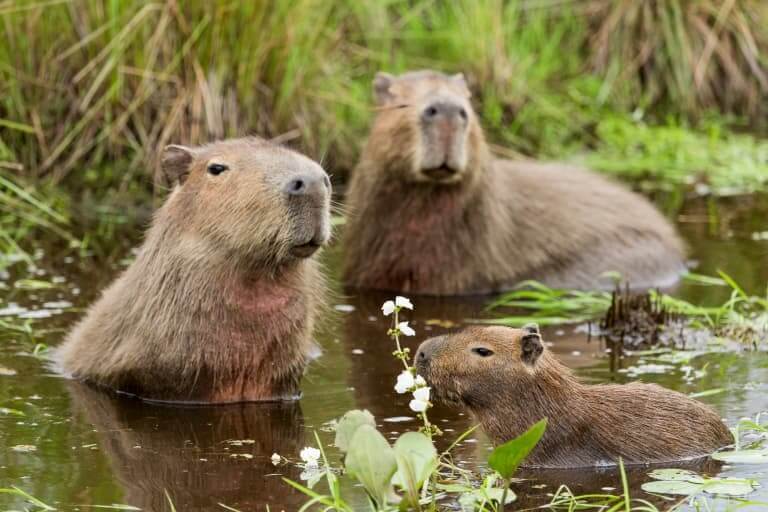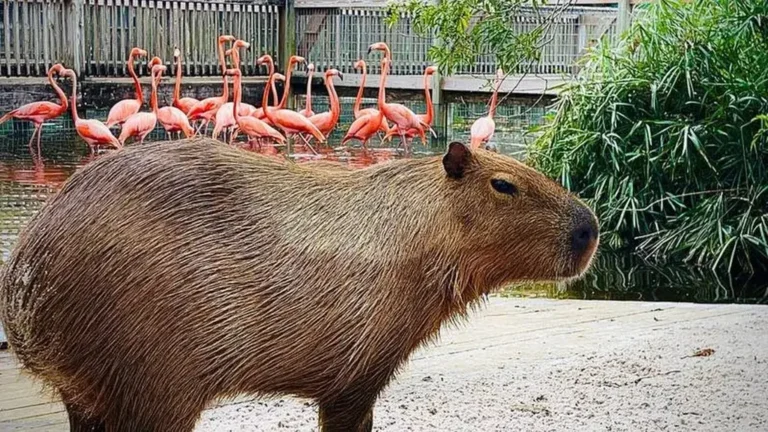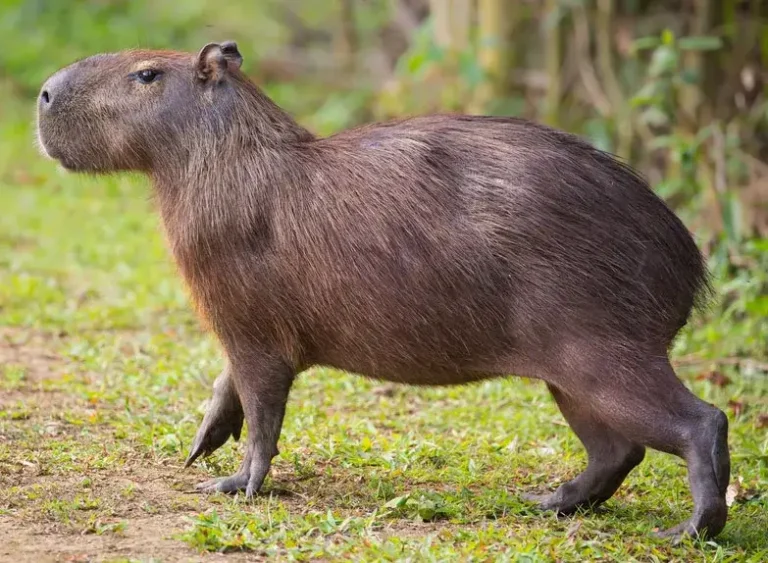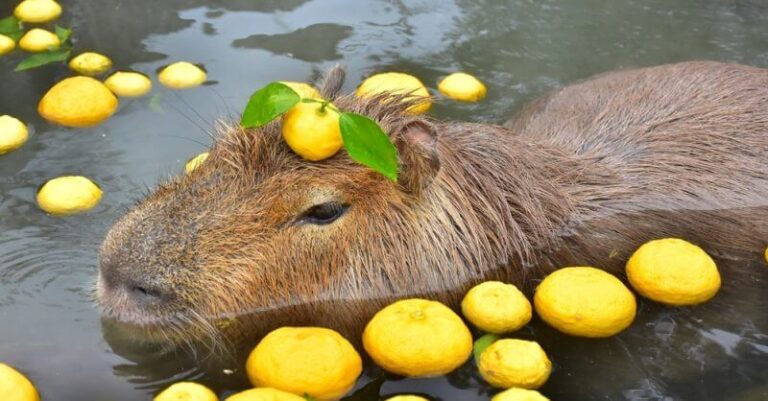What Does Capybaras Eat? Unveiling the Diet of Nature’s Largest Rodents
Capybaras, the gentle giants of the rodent world, inhabit the lush landscapes of South America, often found near rivers and water bodies. These semi-aquatic mammals, known for their peaceful demeanor and social behavior, play a vital role in their ecosystems. Central to understanding their role is unraveling their dietary habits. So, what do capybaras eat to sustain their massive size and maintain their well-being? Let’s delve into the intriguing world of capybara cuisine.
Contents
- 1 What do capybaras eat?
- 2 Capybaras: Nature’s Aquatic Herbivores
- 3 Dietary Staples: A Verdant Buffet
- 4 Nutritional Needs: Balancing the Herbivore’s Plate
- 5 Food Acquisition and Feeding Habits: A Grazing Affair
- 6 Capybaras and Digestion: Unlocking Nature’s Recycling System
- 7 6. Capybaras and Human Interaction: A Tale of Coexistence
- 8 What Do Capybaras Eat in the Rainforest?
- 9 What Do Capybaras Eat in the Wild?
- 10 What Do Capybaras Eat in the Amazon Rainforest?
- 11 What Do Capybaras Eat in Dreamlight Valley?
- 12 What Do Capybaras Eat at Disney Dreamlight?
- 13 What Do Capybaras Eat in the Tropical Rainforest?
Key Takeaway
Capybaras are herbivores primarily eating grasses, aquatic plants, and vegetables. They need a high-fiber diet and also consume bark, fruits, and their own droppings (coprophagy) to help with digestion.
What do capybaras eat?
Capybaras are herbivores, eating grasses, aquatic plants, and vegetables. They consume large amounts of fiber, crucial for their digestion. Additionally, capybaras eat bark and fruits, and practice coprophagy (eating their feces) to obtain extra nutrients.
Capybaras: Nature’s Aquatic Herbivores
Before delving into their diet, grasping the essence of capybaras is essential. These creatures are not just the most giant rodents globally, reaching weights of up to 150 pounds, but epitomize the semi-aquatic lifestyle. Their large bodies, running about three feet, are designed to thrive in and around water bodies. Their presence near rivers is not just a matter of preference; keeping their skin moist and regulating body temperature is necessary.
Related: Are Capybaras Friendly Or Dangerous?
Dietary Staples: A Verdant Buffet
Capybaras predominantly subsist on a vegetarian diet, primarily comprising:
A. Grass and Low-Lying Vegetation:
- Grasses such as Bermuda grass, switchgrass, and crowngrass form the backbone of their diet.
- These herbivores prefer specific grasses, including sedges, known for their nutritional value and accessibility.
- Their grazing behavior, characterized by leisurely munching on grasslands, showcases their adaptation to terrestrial habitats.
B. Aquatic Plants:
- In addition to grasses, capybaras incorporate aquatic plants into their diet, especially in regions abundant in water bodies.
- They consume a variety of aquatic vegetation, including reeds and water lilies, accessing them effortlessly due to their semi-aquatic lifestyle.
Related: The Sociable Side Of Capybaras
Nutritional Needs: Balancing the Herbivore’s Plate
A. Fiber-Rich Diet:
- Capybaras rely heavily on fibrous vegetation, which is crucial for their digestive health and overall well-being.
- Their specialized stomach, featuring multiple chambers, aids in breaking down rigid plant materials and extracting essential nutrients efficiently.
B. Essential Nutrients:
- While fiber constitutes a significant portion of their diet, capybaras also require essential nutrients such as vitamins and minerals for optimal health.
- Their dietary requirements may vary based on seasonal fluctuations and the availability of food sources.
Related: How Much Do Capybaras Weigh?
Food Acquisition and Feeding Habits: A Grazing Affair
A. Grazing Patterns:
- Capybaras exhibit distinctive grazing patterns, often seen leisurely foraging in grasslands and along riverbanks.
- Their daily feeding routines revolve around multiple grazing sessions, ensuring a steady intake of nutrients.
B. Social Feeding Behavior:
- These herbivores often feed in groups, fostering social bonds while foraging.
- While competition for food may arise within groups, capybaras display remarkable tolerance, maintaining harmony during feeding sessions.
Capybaras and Digestion: Unlocking Nature’s Recycling System
A. Hindgut Fermentation:
- The capybara’s digestive system relies on hindgut fermentation, which is vital for breaking down fibrous plant material.
- This intricate digestive mechanism enables capybaras to extract maximum nutrition from their herbivorous diet.
B. Microbial Harmony:
- Within their digestive tract resides a diverse microbial community, essential for aiding digestion and nutrient absorption.
- The symbiotic relationship between capybaras and their gut microbiome highlights nature’s intricate balance.
6. Capybaras and Human Interaction: A Tale of Coexistence
While capybaras generally shy away from human interaction, their presence near agricultural areas can sometimes lead to conflicts. Responsible coexistence involves respecting their natural habitat and refraining from feeding them human food, which can disrupt their dietary balance and health.
7. Conclusion: Celebrating Nature’s Herbivorous Marvels
In conclusion, understanding what capybaras eat unveils the intricate balance of nature’s ecosystem. From grazing on verdant grasslands to leisurely browsing through aquatic vegetation, these gentle giants play a crucial role in shaping their habitats. By appreciating and respecting their dietary needs, we can foster a harmonious relationship with these remarkable herbivores, ensuring their continued existence in the rich tapestry of South American ecosystems.
What Do Capybaras Eat in the Rainforest?
Capybaras primarily feed on vegetation in the rainforest, including grasses, aquatic plants, and fruits. Their diet consists of different plant species found in their habitat, such as sedges, reeds, and ferns. Additionally, capybaras may consume bark and tree leaves, especially during periods of limited food availability. Their herbivorous diet is essential for sustaining their population and contributing to the ecological balance of the rainforest ecosystem.
What Do Capybaras Eat in the Wild?
In the wild, capybaras have a diverse diet consisting mainly of grasses, herbs, and aquatic plants. They are well-adapted to foraging for food in their natural habitats, which include grasslands, wetlands, and tropical forests. Capybaras are opportunistic feeders and will consume a variety of plant species depending on seasonal changes and local availability. Their ability to thrive on a plant-based diet reflects their role as herbivores and primary consumers within their ecosystems.
What Do Capybaras Eat in the Amazon Rainforest?
In the Amazon rainforest, capybaras feed on a wide array of plant species that are abundant in their environment. This includes grasses, sedges, aquatic plants, and fruits from various tree species. The diverse vegetation of the Amazon provides capybaras with ample food sources year-round, allowing them to maintain their population and fulfill their ecological niche as herbivores. Their feeding habits contribute to the Amazon rainforest’s overall biodiversity and nutrient cycling.
What Do Capybaras Eat in Dreamlight Valley?
In Dreamlight Valley, a fictional setting, capybaras may hypothetically feed on vegetation similar to their natural diet in real-world habitats. This could include grasses, herbs, aquatic plants, and possibly fruits or nuts from trees. While Dreamlight Valley is not an actual location, imagining the dietary habits of capybaras in such a setting can provide insight into their role as herbivores and their importance in maintaining ecosystem balance.
What Do Capybaras Eat at Disney Dreamlight?
At Disney Dreamlight, a fictional entertainment venue, capybaras would not have access to their natural diet as they would in their native habitats. In a controlled environment like Disney Dreamlight, capybaras would likely have a specialized diet formulated to meet their nutritional needs. This diet may include hay, fresh greens, and commercially prepared herbivore pellets, ensuring the entertainment facility’s health and well-being of the captive capybaras.
What Do Capybaras Eat in the Tropical Rainforest?
In the tropical rainforest, capybaras consume a diverse array of plant species characteristic of their habitat. This includes grasses, sedges, aquatic plants, and fruits from trees and shrubs. The abundance of vegetation in the tropical rainforest ensures that capybaras have access to a varied diet throughout the year, supporting their population and contributing to the overall biodiversity of the ecosystem. Their role as herbivores highlights their importance in maintaining the delicate balance of the tropical rainforest ecosystem.
Frequently Asked Questions (FAQs) About Capybaras and Their Diet
Q: What do capybaras eat?
A: Capybaras are herbivores, primarily consuming a diet consisting of grasses, aquatic plants, and various types of vegetation. They also feed on fruits, bark, and tree leaves when available.
Q: Do capybaras eat meat?
A: No, capybaras are strictly herbivorous and do not consume meat. Their digestive system is adapted to process plant material efficiently.
Q: How much do capybaras eat in a day?
A: On average, capybaras eat between 3% to 4% of their body weight daily. This equates to approximately six to eight pounds of food daily for an adult capybara.
Q: Do capybaras eat their feces?
A: Capybaras engage in coprophagy, where they consume their feces. This process allows them to extract additional nutrients from their food through a second digestion.
Q: What types of plants do capybaras eat?
A: Capybaras feed on various plants, including sedges, Bermuda grass, and crowngrass. They also consume aquatic plants like reeds, fruits, and vegetation in their habitat.
Q: Are there any plants that capybaras avoid?
A: While capybaras have a broad diet, they may avoid certain plants that are toxic or unpalatable to them. However, their preferences may vary based on individual tastes and the local availability of food.
Q: Do capybaras need to drink water?
A: Yes, capybaras require access to freshwater sources for hydration, as well as for regulating their body temperature and keeping their skin moist. They are often found near rivers, lakes, and marshes in their natural habitat.
Q: Can capybaras eat human food?
A: It is not recommended to feed capybaras human food, as their digestive systems are adapted to process plant material. Providing them with human food can disrupt their natural diet and lead to health issues.
Q: Are capybaras dangerous to humans?
A: Capybaras are generally docile and non-aggressive towards humans. However, they may defend themselves if they feel threatened or cornered. It’s important to respect their space and observe them from a safe distance in their natural habitat.
Q: How does the diet of capybaras impact their environment?
A: Capybaras play a crucial role in their ecosystem by controlling vegetation growth through grazing. By consuming grasses and other plants, they help maintain the balance of plant populations and contribute to the health of wetland and riverine habitats where they reside.
- Golden Retriever Pros and Cons: What Every Pet Parent Should Know - 15 September 2025
- Cane Corso Dog Breed: Health, Care, and Lifespan - 14 September 2025
- Catahoula Leopard Dogs: Description, Temperament, Lifespan, & Facts - 21 July 2025






